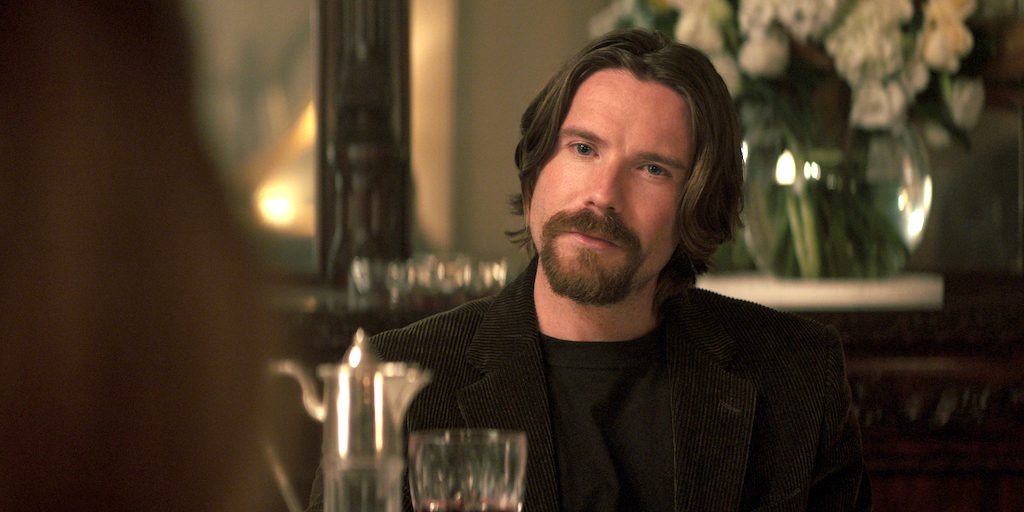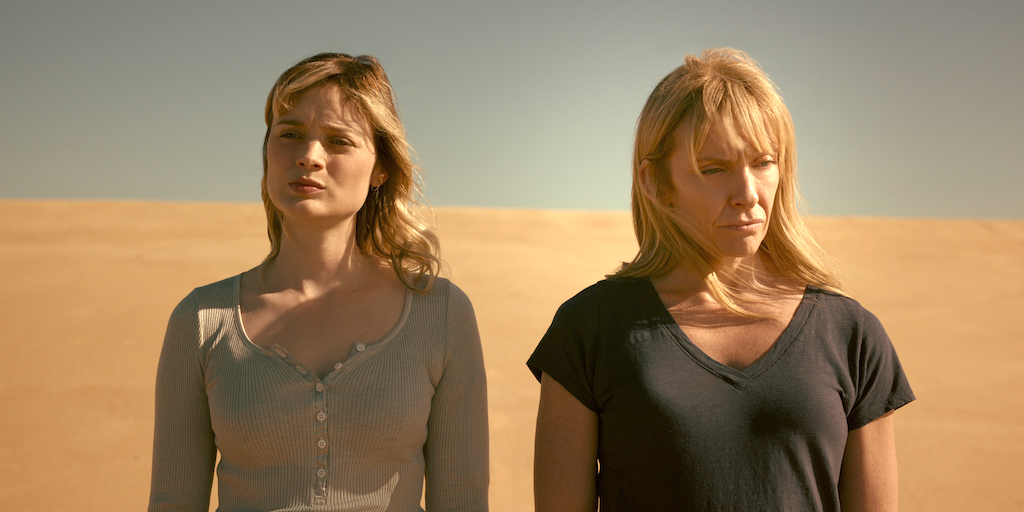This interview contains major spoilers
Adapted from the book by acclaimed novelist Karen Slaughter, Pieces Of Her tells the story of a woman living in witness protection in Georgia as her past unravels. TV writer Charlotte Stoudt (Homeland, Foss/ Verne, House Of Cards) initially read the galleys of Slaughter’s novel in one sitting, which, by her own confession, she didn’t expect. “There’s a lot of propulsion, dour humor, and the way she controls tone. Karen writes in a world that is still credible despite the extraordinary things that happen.”
Imagine if everything you thought you knew about your life and family and yourself is a lie?
This was the bait that compelled Stoudt to create her TV series. She loved the Andy Oliver (Bella Heathcote) story and the Patty Hearst parallels (Patty was abducted by a radical Symbionese Liberation Army).
Pieces Of Her can be distilled to a story of identity – the one’s we take on, the one’s that take us on, and the our truest ones. In order to build audiences, Charlotte focused on two key relationships Jane Queller (Jessica Barden/ Toni Collette) and Nick Harp (Joe Dempsie) and Jane’s assumed identity, Laura (Toni Collette) and Andy Oliver (Bella Heathcote).
Shedding An Old Identity & Building A New One
Stoudt spent considerable time researching the workings of the Witness Protection Program. Typically, the program sends participants to a new town with a new name and backstory and sets them up with a job. “I didn’t understand the thorough process that people go through to enter the program,” she continued. All their former ties, hobbies, and familiar places are discontinued. Then the participants need to maintain that new, fake identity for the rest of their lives.
“When you’re assigned a U.S. Marshall [handler], they pose as your friend for decades,” she added. “After cutting yourself off from your former life, there’s nobody there to be with you when you have a baby, get married or need to attend a funeral.” Your handler is both your warden and your guard. “Handlers are both your jailor and your friend. I love how muddy that is.”

Charlotte Stoudt
To really make her point during pitch meetings, Charlotte posed the question, “What if after this meeting, you had to leave behind your phone, your wedding ring, and never talk to anyone you ever knew in your life again?” This underscores the severity of the program and the strength of character required to live with it. “Many people can’t compartmentalize themselves and leave the program. However, Jane is the perfect candidate because she’s lived her entire life like that.” The process takes a great toll on one’s mental and emotional well-being. This forms the basis for the prickly relationship between Laura and Andy. “Andy senses something is off, but can’t put her finger on it.”
Writing a thriller requires a submersion of the mystery and its gradual revelation. The pilot episode introduced this when Laura and Andy experience a lone gunman at a restaurant. Laura controls the situation in a far more capable fashion than a regular mother, who’s daughter is faced with death.
“I started the series with the simple question of what these women mean to each other rather than Jane’s background,” said Charlotte. After the events, Andy senses that there’s more to Laura than simply being a mom protecting her daughter. “I want her to be implicated in the answer to her questioning who her mom is.“ Stoudt can only reveal a limited amount of backstory in the opening scenes. By the season’s end we find out that Laura is in witness protection, and had an affair with a left wing terrorist. “After these initial shocks, Andy discovers that her mother is capable of some pretty radical actions.” Laura killed her billionaire father and wanted to kill Andy’s father Nick, in order to survive.
Charlotte Stoudt was adopted. Although she was aware of this at an early age, she always wanted to know her origin story. “I met my birth parents in my mid-thirties and discovered some ugly truths I wasn’t prepared for. Ultimately, it doesn’t matter how I got here. What matters, is what am I going to do now.”
Adapting a book into a television series is like packing for a trip. You can’t take all your belongings with you. “It was painful to leave out so much nuanced material, especially in the backstory,” lamented Stoudt. Specifically, the characters living with AIDS, which have a personal relevance to Charlotte.
The clear and present danger in the book is Paula Kunde (Genevieve Hegney) and the kingpin is Nick. These roles were reversed in the TV series. “The main character relationship triangle in the show is between a mother [Jane], a father [Nick], and a daughter [Andy].” Charlotte felt the TV series was better served “if Nick was lurking in the shadows and could show up at any time rather than take center stage.” Paula wasn’t as pivotal to the story, so we made her the controller.
Building Each Episode
The Oslo Economic Conference was instrumental in revealing Jane’s violent past. The first episode was initially planned to cold open with scenes from this fateful conference – Jane and her activist group was there to destroy capitalism. We meet Jane at this time, as a mild-mannered attendee, overwhelmed by the anti-capitalism protests outside. Then she shoots one of the speakers in cold blood. “I didn’t feel this was the best entrance into the story. Laura’s story had to come through her relationship with Andy.”
The show ultimately opened with the armed robbery at the diner. The events triggered Laura’s suppressed memories, which, in turn, propelled the story.

Nick Harp (Joe Dempsie). Photo courtesy Netflix
Writing an intricate thriller with multiple twists and turns requires a keen sense of pacing and delivery of information. “I always move towards simplicity to keep the audience onboard,” said Stoudt of her process. She looked at her writing experience on Homeland for guidance. She identified the cliffhanger at the end of each episode. “I looked at the point where the rug is pulled out from under Andy.”
Similar to her mother Laura, Andy’s closest people are systematically taken away from her as she continues her journey alone. As she travels, she figures out what she’s capable of and when she can finally become independent from her mother and self-sufficient. “This was the emotional bed of Andy’s character underneath all the turns.”
Thematically, each episode was structured around the idea of being one thing and turning out to be someone else. “The information you got wrong propels the audience to keep watching. It’s two steps forward and one step back in every episode.”
Stoudt also kept mother and daughter physically apart, but on each other’s minds for as long as possible (especially during the second half) also helped to maintain the tension throughout the series.
The truth is finally revealed in a thrilling climax and mother and daughter are reunited. But it isn’t a truly happy ending. There’s a sense of ambivalence. “Laura’s a bit unknowable and unreachable. She’s still her own island.” Although Andy has become closer to her mother, they can never be extremely close. “Andy’s moved from seeing Laura as a projection of her mother, to Laura as a person.” Charlotte would like the audience to admire Laura’s strength and endurance, despite her unsavory past.
Pieces Of Her is a mercurial beast. Stoudt described it as “a Lana Del Rey song… dark, cinematic, with a certain romanticism to it. I wanted a lushness to it.” Charlotte recalls her love of Ancient Greek classics, specifically Persephone (daughter) and Demeter’s (mother) desire to rule the earth as creative inspiration fro Laura and Andy. As a result, Persphone is dragged into Haides’ underworld. “The world is frozen until Demeter gets her daughter back… but she doesn’t fully get her back. Things can never be the same.” Stoudt draws these parallels in Pieces Of Her. “I hope the audience feels the deeper bed of it that isn’t even language.”
We asked Charlotte Stoudt what defines her writing. “I love the unknown. I love the perfect meeting of the operational and the emotional.” The clash between the two makes it difficult. “I’m interested in writing about people who can’t resolve a part of themselves and feel they’re being driven by something outside their control.”
In conclusion, she identifies successful writers as those who have fine-tuned their craft with a need to say something powerful.
